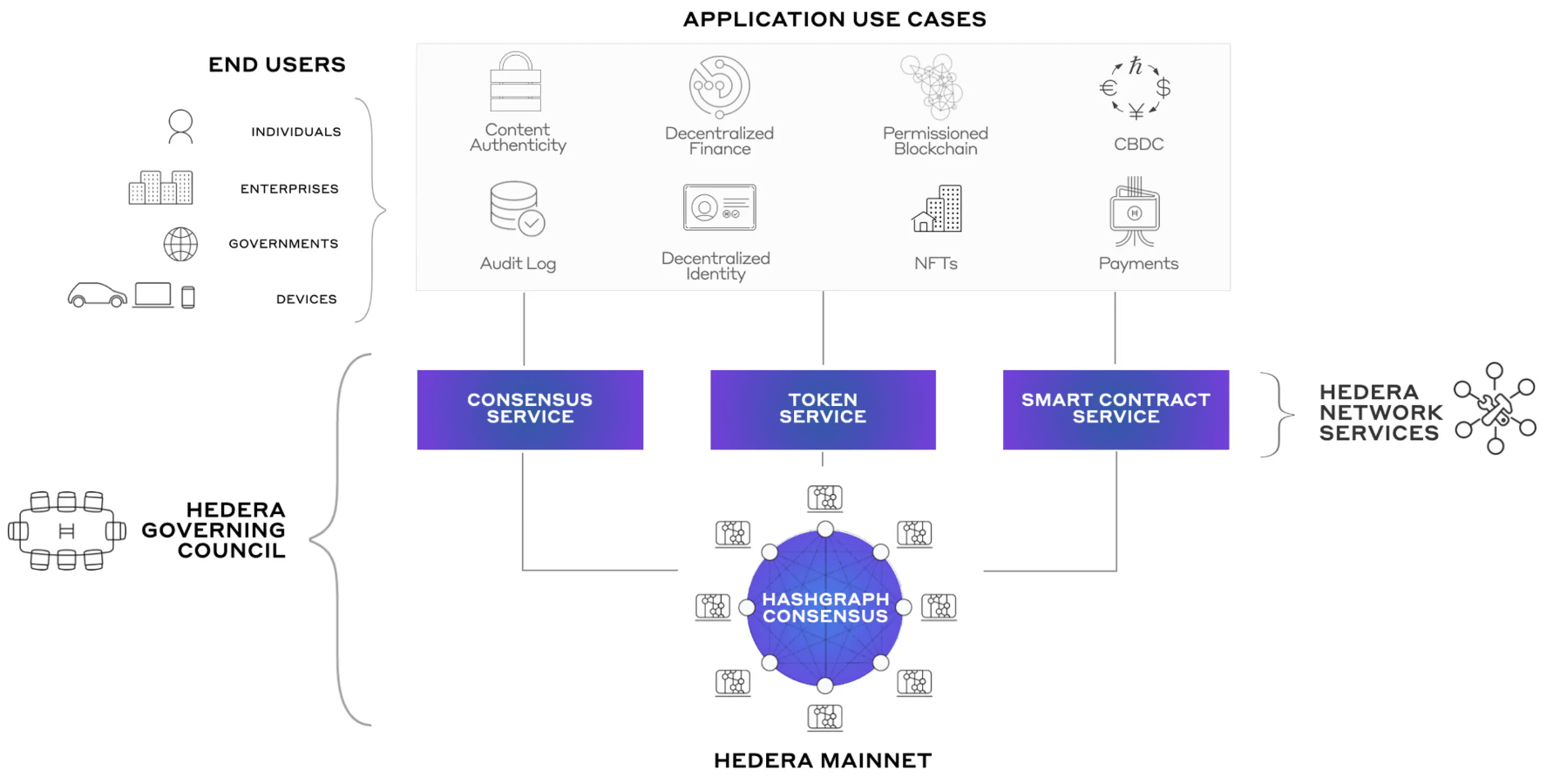
What Is Hedera Blockchain?
Hedera is a fully open, proof-of-stake public network and governing body for building and deploying decentralized applications. It is managed by leading global organizations, ensuring the network’s reliability and stability.
The native token of the platform, Hedera Hashgraph Token (HBAR), is used for paying transaction fees, securing the network, and incentivizing ecosystem participants. HBAR plays a crucial role in maintaining the decentralized nature of the network, allowing users to actively participate in its governance and development.
Differences Between Hedera Blockchain and Other Blockchains
Hedera stands out from other blockchains with its unique technological and governance approaches. Here are the key features:
-
Hashgraph Technology: Hedera uses a Directed Acyclic Graph (DAG) instead of traditional blockchain structures. This ensures high performance and fast transaction speeds.
-
Hybrid Decentralization: The network is governed by a Council of world-leading companies, striking a balance between decentralization and trust.
-
Energy Efficiency: Hedera consumes significantly less energy compared to traditional blockchains like Bitcoin, making it an environmentally sustainable choice.
-
Predictably Low Fees: With fixed and minimal transaction costs, the network is accessible for a wide range of uses, from microtransactions to large-scale corporate solutions.
These unique features make Hedera a leader among modern blockchain platforms, suitable for both individual users and large enterprises.
What Makes Hedera Unique?
Hedera offers unique capabilities thanks to its innovations, governance model, and scalability. This platform is designed to address the limitations of traditional blockchains, delivering speed, security, and efficiency.
1. Hashgraph Technology
Hedera uses a unique hashgraph technology, which is an alternative to traditional blockchains, based on a Directed Acyclic Graph (DAG). Instead of linear blocks, hashgraph applies a “gossip-about-gossip” mechanism to quickly spread information and achieve consensus. With distributed timestamps and high throughput, the network processes up to 10,000 transactions per second with minimal latency. Unlike Proof-of-Work blockchains, hashgraph is energy-efficient and scalable, making Hedera a reliable platform for building decentralized applications (DApps).
2. Hybrid Decentralization
Hedera’s governance is managed by a council of 39 global industry leaders, including companies like Google, IBM, and LG. This structure ensures transparent decision-making and prevents centralization. Council members represent diverse industries and regions, contributing to the network’s resilience and stability.
3. Security and Resilience
Hedera employs Asynchronous Byzantine Fault Tolerance (ABFT), making it one of the most secure networks available. This guarantees that even during attacks or partial system failures, the network continues to operate without data loss.
4. Support for Smart Contracts and Tokenization
Hedera provides robust tools for creating tokens and smart contracts. Developers can easily migrate applications from the Ethereum ecosystem thanks to its EVM compatibility. The platform also enables the creation of unique NFTs and decentralized financial (DeFi) solutions.
 Overview of Hedera Blockchain Services and Use Cases. Source: hedera.com
Overview of Hedera Blockchain Services and Use Cases. Source: hedera.com
HBAR: Native Token of Hedera Network
The native token of Hedera, HBAR, is the foundation of its ecosystem. It acts as both a utility and governance token, powering the network, securing its infrastructure, and supporting various use cases. With fast and low-cost transactions, as well as the ability to support decentralized applications, HBAR has become an essential part of Hedera, helping developers and users make the most of its features.
Use Cases of Hedera (HBAR)
Hedera provides numerous applications due to its high transaction speed, minimal fees, and decentralized structure:
-
Transaction Payments: HBAR is used to cover the low fees for transactions on the network. The cost of a single operation is just a fraction of a cent, making Hedera accessible even for micropayments.
-
Ensuring Security: HBAR supports the network’s Proof-of-Stake mechanism to ensure security. Token holders can participate in staking, helping to maintain the system’s stability.
-
Building Decentralized Applications: HBAR is essential for deploying smart contracts, tokenizing assets, and running various decentralized applications (DApps). This makes it a versatile tool for developers.
-
Supporting Eco-Friendly Solutions: HBAR is actively used in projects focused on minimal energy consumption, making it a key element for environmentally sustainable applications.
To manage and securely store HBAR tokens, you can use the Hedera Wallet. This self-custody, open-source wallet provides complete independence and control over your assets, offering users a simple and reliable tool to interact with the Hedera network.
